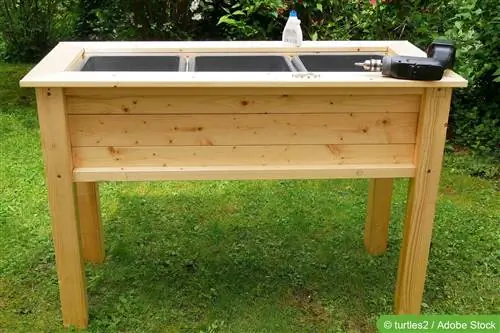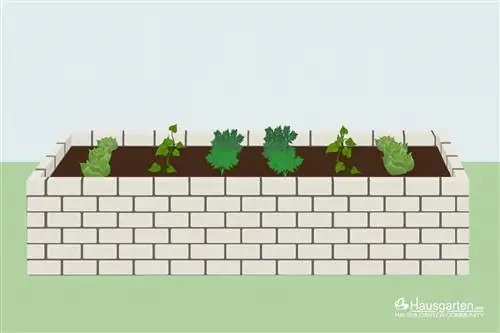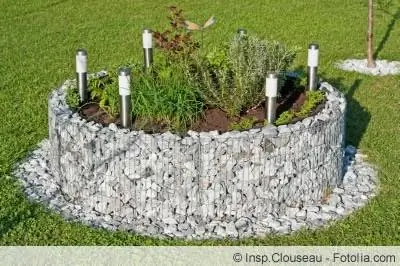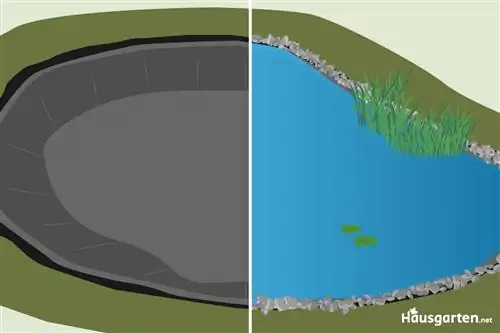- Author admin [email protected].
- Public 2023-12-17 03:39.
- Last modified 2025-01-24 12:45.
Gardening becomes easier with the right raised bed. Voles and snails have no chance, the yield is increased and plant care is easy on your back from cultivation to harvest. A decorative raised bed can also be an eye-catcher. However, finished models are expensive, at least if they have to have a large volume and high stability. And even then, they often cannot be found in the right size. A raised bed is the best alternative here. But what should you pay attention to?
Planning
If you plan to build a raised bed yourself, you should first consider a few factors. The following questions can help.
- Where should the raised bed be?
- How much space is there?
- Is a fixed location planned or should the bed be mobile?
The answers decide the possible height, length and width, as well as the other structure of the raised bed. A permanently placed bed can be anchored in the earth for additional stability and can take on enormous dimensions. Mobile versions, which are intended to change location if necessary and depending on the plants, require additional wheels and should not be too large.
Material and tools
The easiest and most cost-effective material for building your own raised bed is wood. These can be stable boards, square timbers, planks, halved round timbers, slats or panels. In addition to these, other materials and tools are of course required.
These are:
- Square timbers as corner points
- Narrow-meshed wire
- Pond Liner
- Screws or nails
- Spirit level
- Hammer
- Cordless screwdriver
- Tacker
- Cutter
- pliers
- Spade
- pencil
- Inch rule
- Possibly rolls
- Possibly saw and sandpaper
Step by step
Once the dimensions have been determined and the material is ready, construction can begin. This initially differs slightly for mobile and fixed raised beds.
Instructions for fixed raised beds
- For permanently installed raised beds, the corner points must first be determined. For this purpose, the square timbers are driven or buried into the ground at an appropriate distance and evenly. The exact alignment and height should be checked with a spirit level and ruler. Marking the wood beforehand helps to find the correct driving depth of each post.
- Markings are made on the squared timbers at the bottom edge of the bed - again using a spirit level and folding rule. These should be straight and at least two centimeters above the ground.
- The selected material for the bed walls is attached to the posts from bottom to top. If possible, there should be no gaps left.
- To prevent the wood from rotting, the inside of the raised bed is lined with pond liner. It can be nailed, stapled or glued at small intervals.
- At the bottom, close-meshed wire, each ten centimeters longer and wider than the bed, is cut to size.
- The wire is cut diagonally or vertically at the corner points and five centimeters wide each. The resulting edges are bent upwards and the wire is placed in the raised bed.
- The edges are to be attached at close intervals to the inside of the wood, above the foil. This can be done using nails or staples at short intervals. The bottom of the wire should line up with the bottom of the walls.
Tip:
For larger meshes, insert the wire twice so that no substrate can fall out.
Construction of mobile raised beds
- Align two square pieces of wood straight. The distance corresponds to the length of the raised bed.
- Determine distances up and down and mark them on the posts.
- Attach planks or boards to the wood. Use the spirit level to ensure that the installation is straight and without gaps.
- Repeat steps one to three for the second, long side wall.
- With the help of a second person, erect the resulting bed walls. The third wall is now built as a connection at the appropriate distance. To do this, the selected boards or planks are also attached to the posts.
- Attach the fourth wall board by board.
- Place the now finished frame on its side and cut the wire mesh to size. The wire should be as long and wide as the outer edges of the frame itself.
- The wire mesh is attached all around the underside of the raised bed. For larger meshes, it may be necessary to apply several overlapping layers.
- For easy moving, additional rollers can be attached to the square timbers.
Tip:
If you also want to use the raised bed as a cold frame, you should attach the appropriate brackets during construction. Or use scaffolding when filling at the latest.
Tips and helpful hints
So that the raised bed looks good not only in the first year and can withstand both the weather and the pressure of the substrate, there are a few special features to consider during construction. First of all, this concerns the selection of wood. Weather-resistant hardwoods that are used for building terraces or fences are suitable. Below:
- Douglas fir
- Larch
- Garapa
- Oak
- Ipe
- Bangkirai
- Robinie
- sweet chestnut
- Pressure Treated Pine
- Thermowood
On the outside, additional treatment with oil, glaze or varnish is recommended. The product chosen should of course also be suitable for outdoor use. Additional impregnation on the inside is not necessary if the pond liner mentioned above is attached here. This protects the wood from moisture and tannins from the substrate used and thus ensures a long service life.
But even with meticulously applied care products, the wood can bend over time. An additional post should therefore be inserted approximately every 100 cm to ensure stability and durability of the shape. For raised beds that exceed a height of 80 cm, the distance can be reduced to half a meter.
If you rely on a permanently mounted model that is at least buried along the posts, you may be tempted to forego the wire insert. This is precisely what provides protection against voles and is therefore useful. A distance from the ground is also an advantage as it ensures better water drainage.
The dimensions are also important for the care of the bed from planting the plants to harvesting. Heights of 60 to 100 cm are suitable for back-friendly work. Up to 140 cm wide can be easily weeded and trimmed - even in the middle of the raised bed. Beyond that, however, it becomes difficult.
Prepare and care for the bed
Once the frame of the raised bed is in place, it is of course far from ready for planting. The appropriate filling is still missing. Ideally, this consists of pottery shards, grit and gravel directly on the wire. Coarse and fine cutting of trees, shrubs and bushes are also suitable. Only then should compost and then the appropriate substrate be added. When growing heavy-feeding plants, it is optimal to bring in the soil a few months before cultivation. In this way, nutrients can be distributed evenly and the substrate has the opportunity to settle.
Approximately every five years the nutrients in the raised bed are decomposed and used up and the soil sinks significantly. This is especially the case with an underlayer made of cut material.
If this occurs, all filling should be removed and replaced. Mobile raised beds can be turned over for this purpose. Larger models require emptying using a bucket and shovel.
Frequently asked questions
How often does the wood of the raised bed need to be protected?
Depending on the wood and impregnation agent chosen, sanding the surface and reapplying it every three to five years is recommended.
Can I also use a raised bed as a greenhouse or cold frame?
If there is enough space between the filling and the upper edge of the bed, the raised bed can certainly serve as a cold frame or greenhouse. To do this, simply cover the opening with foil, glass or plexiglass. This finish becomes visually decorative and practical in function when it is fitted with a frame and hinges.
Interesting facts
Raised beds can be made from a wide variety of materials. A particularly stable construction can be achieved with used railway sleepers. From a hygienic point of view, however, you should line this raised bed with foil so that the pollutants it contains cannot reach the plant's roots via the soil. Construction made of spruce palisades is also rustic. The old frame made of logs in block construction must be attached to the posts that are vertically inserted into the ground. The posts are best placed in a drainage layer or a small concrete foundation in the ground. If you build the simple type of raised bed, you can do this with 10 to 15 cm thick spruce trees.
Bed surface should be about 70 cm high. You shouldn't make it any higher, otherwise you would have to add further stabilization. So that you can work very well in the middle of the bed and can easily reach the middle from both sides, you should make sure that the bed is not wider than 1.20 m.
If you want to save the beam of your raised bed from coming into contact with soil, you can attach a weather-resistant film to the inside. This film contributes significantly to the longer life of the raised bed.
If theframe of the raised bed is closed, a drainage layer of coarse gravel is filled at the bottom. If you want to fill your raised bed, you should first fill in a layer of reduced branches. This should also ensure good ventilation.
It is important that the material can rot within the raised bed. Then you fill in bedding soil and start planting or sowing.






